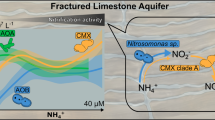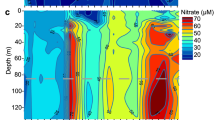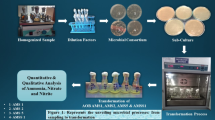Abstract
The occurrence of nitrification in the oceanic water column has implications extending from local effects on the structure and activity of phytoplankton communities to broader impacts on the speciation of nitrogenous nutrients and production of nitrous oxide. The ammonia-oxidizing archaea, responsible for carrying out the majority of nitrification in the sea, are present in the marine water column as two taxonomically distinct groups. Water column group A (WCA) organisms are detected at all depths, whereas Water column group B (WCB) are present primarily below the photic zone. An open question in marine biogeochemistry is whether the taxonomic definition of WCA and WCB organisms and their observed distributions correspond to distinct ecological and biogeochemical niches. We used the natural gradients in physicochemical and biological properties that upwelling establishes in surface waters to study their roles in nitrification, and how their activity—ascertained from quantification of ecotype-specific ammonia monooxygenase (amoA) genes and transcripts—varies in response to environmental fluctuations. Our results indicate a role for both ecotypes in nitrification in Monterey Bay surface waters. However, their respective contributions vary, due to their different sensitivities to surface water conditions. WCA organisms exhibited a remarkably consistent level of activity and their contribution to nitrification appears to be related to community size. WCB activity was less consistent and primarily constrained to colder, high nutrient and low chlorophyll waters. Overall, the results of our characterization yielded a strong, potentially predictive, relationship between archaeal amoA gene abundance and the rate of nitrification.
Similar content being viewed by others
Log in or create a free account to read this content
Gain free access to this article, as well as selected content from this journal and more on nature.com
or
References
Agogué H, Brink M, Dinasquet J, Herndl GJ . (2008). Major gradients in putatively nitrifying and non-nitrifying Archaea in the deep North Atlantic. Nature 456: 788–791.
Alonso-Sáez L, Waller AS, Mende DR, Bakker K, Farnelid H, Yager PL et al. (2012). Role for urea in nitrification by polar marine Archaea. Proc Natl Acad Sci USA 109: 17989–17994.
Andersson AF, Lundgren M, Eriksson S, Rosenlund M, Bernander R, Nilsson P . (2006). Global analysis of mRNA stability in the archaeon. Sulfolobus Genome Biol 7: R99.
Baker BJ, Lesniewski RA, Dick GJ . (2012). Genome-enabled transcriptomics reveals archaeal populations that drive nitrification in a deep-sea hydrothermal plume. ISME J 6: 2269–2279.
Beman JM, Chow C-E, King AL, Feng Y, Fuhrman JA, Andersson A et al. (2011). Global declines in oceanic nitrification rates as a consequence of ocean acidification. Proc Natl Acad Sci USA 108: 208–213.
Beman JM, Popp BN, Alford SE . (2012). Quantification of ammonia oxidation rates and ammonia-oxidizing archaea and bacteria at high resolution in the Gulf of California and eastern tropical North Pacific Ocean. Limnol Oceanogr 57: 711–726.
Beman JM, Popp BN, Francis CA . (2008). Molecular and biogeochemical evidence for ammonia oxidation by marine Crenarchaeota in the Gulf of California. ISME J 2: 429–441.
Beman JM, Sachdeva R, Fuhrman JA . (2010). Population ecology of nitrifying Archaea and Bacteria in the Southern California Bight. Environ Microbiol 12: 1282–1292.
Blainey PC, Mosier AC, Potanina A, Francis CA, Quake SR . (2011). Genome of a low-salinity ammonia oxidizing archaeon determined by single-cell and metagenomic analysis. PLoS One 6: e16626.
Breaker LC, Broenkow WW . (1994). The circulation of Monterey Bay and related processes. Oceanogr Mar Biol 32: 1–64.
Casciotti KL, Sigman DM, Galanter Hastings M, Böhlke JK, Hilkert A . (2002). Measurement of the oxygen isotopic composition of nitrate in seawater and freshwater using the denitrifier method. Anal Chem 74: 4905–4912.
Casciotti KL, Trull TW, Glover DM, Davies D . (2008). Constraints on nitrogen cycling at the subtropical North Pacific Station ALOHA from isotopic measurements of nitrate and particulate nitrogen. Deep-Sea Res Pt II 55: 1661–1672.
Christman GD, Cottrell MT, Popp BN, Gier E, Kirchman DL . (2011). Abundance, diversity, and activity of ammonia-oxidizing prokaryotes in the coastal Arctic Ocean in summer and winter. Appl Environ Microbiol 77: 2026–2034.
Church MJ, Wai B, Karl DM, DeLong EF . (2010). Abundances of crenarchaeal amoA genes and transcripts in the Pacific Ocean. Environ Microbiol 12: 679–668.
Clark DR, Rees AP, Joint I . (2008). Ammonium regeneration and nitrification rates in the oligotrophic Atlantic Ocean: implications for new production estimates. Limnol Oceanogr 53: 52.
DeLong EF . (1992). Archaea in coastal marine environments. Proc Natl Acad Sci USA 89: 5685–5689.
Dortch Q . (1990). The interaction between ammonium and nitrate uptake in phytoplankton. Mar Ecol Prog Ser 61: 183–201.
Dugdale RC, Wilkerson FP, Hogue VE, Marchi A . (2006). Nutrient controls on new production in the Bodega Bay, California, coastal upwelling plume. Deep-Sea Res Pt II 53: 3049–3062.
Fawcett SE, Ward BB . (2011). Phytoplankton succession and nitrogen utilization during the development of an upwelling bloom. Mar Ecol Prog Ser 428: 13–31.
Francis CA, Roberts KJ, Beman JM, Santoro AE, Oakley BB . (2005). Ubiquity and diversity of ammonia-oxidizing archaea in water columns and sediments of the ocean. Proc Natl Acad Sci USA 102: 14683–14688.
Fuhrman JA, McCallum K, Davis AA . (1992). Novel major archaebacterial group from marine plankton. Nature 356: 148–149.
Garcia-Martinez J, Rodriguez-Valera F . (2000). Microdiversity of uncultured marine prokaryotes: the SAR11 cluster and the marine Archaea of Group I. Mol Ecol 9: 935–948.
Gruber N . (2011). Warming up, turning sour, losing breath: ocean biogeochemistry under global change. Philos Trans R Soc A Math Phys Eng Sci 369: 1980–1996.
Hallam SJ, Mincer TJ, Schleper C, Preston CM, Roberts K, Richardson PM et al. (2006). Pathways of carbon assimilation and ammonia oxidation suggesed by environmental genomic analyses of marine Crenarchaeota. PLoS Biol 4: e95.
Hansman RL, Griffin S, Watson JT, Druffel ERM, Ingalls AE, Pearson A et al. (2009). The radiocarbon signature of microorganisms in the mesopelagic ocean. Proc Natl Acad Sci USA 106: 6513–6518.
Herndl GJ, Reinthaler T, Teira E, van Aken H, Veth C, Pernthaler A et al. (2005). Contribution of Archaea to total prokaryotic production in the deep Atlantic Ocean. Appl Environ Microbiol 71: 2303–2309.
Hollibaugh JT, Gifford S, Sharma S, Bano N, Moran MA . (2010). Metatranscriptomic analysis of ammonia-oxidizing organisms in an estuarine bacterioplankton assemblage. ISME J 5: 866–878.
Holmes RM, Aminot A, Kérouel R, Hooker BA, Peterson BJ . (1999). A simple and precise method for measuring ammonium in marine and freshwater ecosystems. Can J Fish Aquat Sci 56: 1801–1808.
Horak REA, Qin W, Schauer AJ, Armbrust EV, Ingalls AE, Moffett JW et al. (2013). Ammonia oxidation kinetics and temperature sensitivity of a natural marine community dominated by Archaea. ISME J doi:10.1038.ismej2013.75.
Horrigan SG, Carlucci AF, Williams PM . (1981). Light inhibition of nitrification in sea-surface films. J Mar Res 39: 557–565.
Ingalls AE, Shah SR, Hansman RL, Aluwihare LI, Santos GM, Druffel ERM et al. (2006). Quantifying archaeal community autotrophy in the mesopelagic ocean using natural radiocarbon. Proc Natl Acad Sci USA 103: 6442–6447.
Karner MB, DeLong EF, Karl DM . (2001). Archaeal dominance in the mesopelagic zone of the Pacific Ocean. Nature 409: 507–510.
Könneke M, Bernhard AE, la Torre de JR, Walker CB, Waterbury JB, Stahl DA . (2005). Isolation of an autotrophic ammonia-oxidizing marine archaeon. Nature 437: 543–546.
Kudela RM, Cochlan WP, Dugdale RC . (1997). Carbon and nitrogen uptake response to light by phytoplankton during an upwelling event. J Plankton Res 19: 609–630.
Kudela RM, Dugdale RC . (2000). Nutrient regulation of phytoplankton productivity in Monterey Bay, California. Deep-Sea Res Pt II 47: 1023–1053.
Labrenz M, Sintes E, Toetzke F, Zumsteg A, Herndl GJ, Seidler M et al. (2010). Relevance of a crenarchaeotal subcluster related to Candidatus Nitrosopumilus maritimus to ammonia oxidation in the suboxic zone of the central Baltic Sea. ISME J 4: 1496–1508.
Lam P, Jensen MM, Lavik G, McGinnis DF, Müller B, Schubert CJ et al. (2007). Linking crenarchaeal and bacterial nitrification to anammox in the Black Sea. Proc Natl Acad Sci USA 104: 7104–7109.
Lam P, Lavik G, Jensen MM, van de Vossenberg J, Schmid M, Woebken D et al. (2009). Revising the nitrogen cycle in the Peruvian oxygen minimum zone. Proc Natl Acad Sci USA 106: 4752–4757.
Lund MB, Smith JM, Francis CA . (2012). Diversity, abundance and expression of nitrite reductase (nirK)-like genes in marine thaumarchaea. ISME J 6: 1966–1977.
Martens-Habbena W, Berube PM, Urakawa H, la Torre de JR, Stahl DA . (2009). Ammonia oxidation kinetics determine niche separation of nitrifying Archaea and Bacteria. Nature 461: 976–979.
Merbt SN, Stahl DA, Casamayor EO, Martí E, Nicol GW, Prosser JI . (2011). Differential photoinhibition of bacterial and archaeal ammonia oxidation. FEMS Microbiol Lett 327: 41–46.
Messié M, Ledesma J, Kolber DD, Michisaki RP, Foley DG, Chavez FP . (2009). Potential new production estimates in four eastern boundary upwelling ecosystems. Prog Oceanogr 83: 151–158.
Mincer TJ, Church MJ, Taylor LT, Preston C, Karl DM, DeLong EF . (2007). Quantitative distribution of presumptive archaeal and bacterial nitrifiers in Monterey Bay and the North Pacific Subtropical Gyre. Environ Microbiol 9: 1162–1175.
Moran MA, Satinsky B, Gifford SM, Luo H, Rivers A, Chan L-K et al. (2012). Sizing up metatranscriptomics. ISME J 7: 237–243.
Mosier AC, Francis CA . (2011). Determining the distribution of marine and coastal ammonia-oxidizing archaea and bacteria using a quantitative approach. Method Enzymol 486: 206–221.
Newell SE, Babbin AR, Jayakumar A, Ward BB . (2011). Ammonia oxidation rates and nitrification in the Arabian Sea. Global Biogeochem Cy 25: GB4016.
Newell SE, Facwett SE, Ward BB . (2013). Depth distribution of ammonia oxidation rates and ammonia-oxidizer community composition in the Sargasso Sea. Limnol Oceanogr 58: 1491–1500.
Olson RJ . (1981a). 15N tracer studies of the primary nitrite maximum. J Mar Res 39: 203–226.
Olson RJ . (1981b). Differential photoinhibition of marine nitrifying bacteria: a possible mechanism for the formation of the primary nitrite maximum. J Mar Res 39: 227–238.
Ouverney CC, Fuhrman JA . (2000). Marine planktonic archaea take up amino acids. Appl Environ Microbiol 66: 4829–4833.
Pennington JT, Chavez FP . (2000). Seasonal fluctuations of temperature, salinity, nitrate, chlorophyll and primary production at station H3/M1 over 1989–1996 in Monterey Bay, California. Deep-Sea Res Pt II 47: 947–973.
Preston CM, Harris A, Ryan JP, Roman B, Marin R, Jensen S et al. (2011). Underwater application of quantitative PCR on an ocean mooring. PLoS One 6: e22522.
Raimbault P, Garcia N, Cerutti F . (2008). Distribution of inorganic and organic nutrients in the south pacific ocean—evidence for long-term accumulation of organic matter in nitrogen-depleted waters. Biogeosci Discuss 5: 281–298.
Robidart JC, Preston CM, Paerl RW, Turk KA, Mosier AC, Francis CA et al. (2011). Seasonal Synechococcus and Thaumarchaeal population dynamics examined with high resolution with remote in situ instrumentation. ISME J 6: 513–523.
Santoro AE, Buchwald C, McIlvin MR, Casciotti KL . (2011). Isotopic signature of N2O produced by marine ammonia-oxidizing archaea. Science 333: 1282–1285.
Santoro AE, Casciotti KL, Francis CA . (2010). Activity, abundance and diversity of nitrifying archaea and bacteria in the central California Current. Environ Microbiol 12: 1989–2006.
Santoro AE, Sakamoto CM, Smith JM, Plant JN, Gehman AL, Worden AZ et al. (2013). Measurements of nitrite production and nitrite-producing organisms in and around the primary nitrite maximum in the central California Current. Biogeosci Discuss 10: 5803–5840.
Sigman DM, Casciotti KL, Andreani M, Barford C, Galanter M, Böhlke JK . (2001). A bacterial method for the nitrogen isotopic analysis of nitrate in seawater and freshwater. Anal Chem 73: 4145–4153.
Sintes E, Bergauer K, De Corte D, Yokokawa T, Herndl GJ . (2013). Archaeal amoA gene diversity points to distinct biogeography of ammonia—oxidizing Crenarchaeota in the ocean. Environ Microbiol 15: 1647–1658.
Steglich C, Lindell D, Futschik M, Rector T, Steen R, Chisholm SW . (2010). Research Short RNA half-lives in the slow-growing marine cyanobacterium Prochlorococcus. Genome Biol 11: R54.
Swan BK, Martinez-Garcia M, Preston CM, Sczyrba A, Woyke T, Lamy D et al. (2011). Potential for chemolithoautotrophy among ubiquitous bacteria lineages in the dark ocean. Science 333: 1296–1300.
Venter JC, Remington K, Heidelberg JF, Halpern AL, Rusch D, Eisen JA et al. (2004). Environmental genome shotgun sequencing of the Sargasso Sea. Science 304: 66–74.
Waldbauer JR, Rodrigue S, Coleman ML, Chisholm SW . (2012). Transciptome and proteome dynamics of a light-dark synchronized bacterial cell cycle. PLoS One 7: e43432.
Walker CB, la Torre de JR, Klotz MG, Urakawa H, Pinel N, Arp DJ et al. (2010). Nitrosopumilus maritimus genome reveals unique mechanisms for nitrification and autotrophy in globally distributed marine crenarchaea. Proc Natl Acad Sci USA 107: 8818–8823.
Ward BB . (1985). Light and substrate concentration relationships with marine ammonium assimilation and oxidation rates. Mar Chem 16: 301–316.
Ward BB . (2005). Temporal variability in nitrification rates and related biogeochemical factors in Monterey Bay, California, USA. MarEcol Prog Ser 292: 97–109.
Ward BB, Kilpatrick KA, Renger EH, Eppley RW . (1989). Biological nitrogen cycling in the nitracline. Limnol Oceanogr 34: 493–513.
Wuchter C, Abbas B, Coolen MJL, Herfort L, van Bleijswijk J, Timmers P et al. (2006). Archaeal nitrification in the ocean. Proc Natl Acad Sci USA 103: 12317–12322.
Yakimov MM, La Cono V, Smedile F, DeLuca TH, Juárez S, Ciordia S et al. (2011). Contribution of crenarchaeal autotrophic ammonia oxidizers to the dark primary production in Tyrrhenian deep waters (Central Mediterranean Sea). ISME J 5: 945–961.
Yool A, Martin AP, Fernández C, Clark DR . (2007). The significance of nitrification for oceanic new production. Nature 447: 999–1002.
Acknowledgements
Tim Pennington, Marguerite Blum, Marie Lund and Julian Damashek provided invaluable logistical assistance with expedition planning and sample acquisition. This work was supported in part by the National Science Foundation Grant OCE-0825363 to CAF. Salary support for JMS came from a graduate research fellowship from the Northern California chapter of the ARCS Foundation. FPC was supported by the David and Lucile Packard Foundation.
Author information
Authors and Affiliations
Corresponding author
Additional information
Supplementary Information accompanies this paper on The ISME Journal website
Supplementary information
Rights and permissions
About this article
Cite this article
Smith, J., Casciotti, K., Chavez, F. et al. Differential contributions of archaeal ammonia oxidizer ecotypes to nitrification in coastal surface waters. ISME J 8, 1704–1714 (2014). https://doi.org/10.1038/ismej.2014.11
Received:
Revised:
Accepted:
Published:
Issue date:
DOI: https://doi.org/10.1038/ismej.2014.11
Keywords
This article is cited by
-
Phylotype resolved spatial variation and association patterns of planktonic Thaumarchaeota in eastern Chinese marginal seas
Marine Life Science & Technology (2023)
-
Alternative strategies of nutrient acquisition and energy conservation map to the biogeography of marine ammonia-oxidizing archaea
The ISME Journal (2020)
-
Differential co-occurrence relationships shaping ecotype diversification within Thaumarchaeota populations in the coastal ocean water column
The ISME Journal (2019)
-
Light and temperature control the seasonal distribution of thaumarchaeota in the South Atlantic bight
The ISME Journal (2018)
-
Diel Rhythm Does Not Shape the Vertical Distribution of Bacterial and Archaeal 16S rRNA Transcript Diversity in Intertidal Sediments: a Mesocosm Study
Microbial Ecology (2018)



